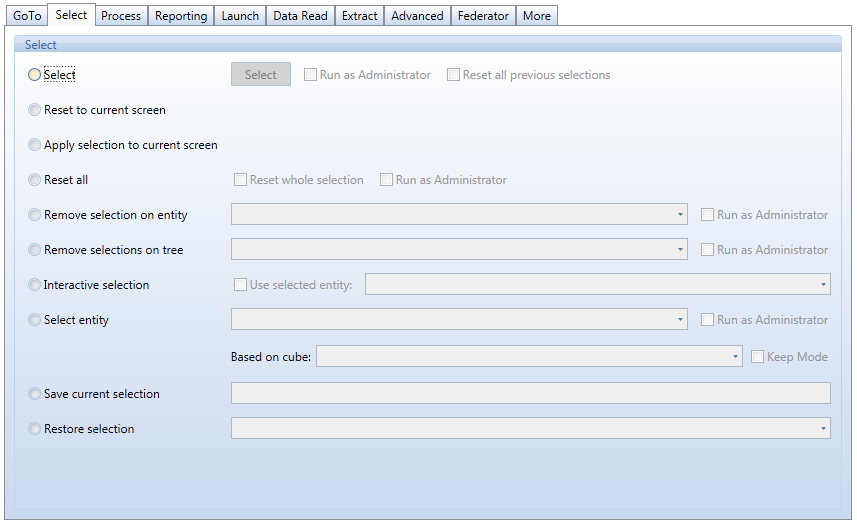

The Select action modifies the active Select (range or filter on the entities members) defining the scope of execution of subsequent actions.
When a procedure starts, the range or scope of execution on the entities is inherited from the Select and the pager selections of the screen from which the procedure is launched. The Select action allows the programmer to modify the range of entity members to include (or exclude) in the processing.
Select. Allows to make a selection on entity members, defining the range of items on which subsequent actions are performed.
Note:
The selections defined here are combined or nested within the active selection inherited from the capsule screen from where the procedure is launched or determined by preceding actions of the procedure. To make a Select which fully replaces any prior selection, tick the option Reset all previous selections.
The following options can be set:
Run as Administrator : allows to make a selection which runs outside the scope determined by the security of the user running the procedure. For example, consider a user having a security selection on Cost Center A, this option allows to make a selection on another cost center or all cost centers, so that it becomes possible for example to allocate an expense or revenue to another cost center on which the user doesn't have access rights. This option can only be enabled by users having administrative rights.
Reset all previous selections : resets any prior selection so that the selection made is not nested to prior selections but replaces any prior selection.
Reset to current screen. Resets the selection to the state of the select when the procedure was launched.
Apply selection to current screen. Applies the current Select of the procedure (with all the changes determined by the prior Select actions) to the current screen.
Note:
This action must be followed by a Refresh screen action in order to actually refresh the data viewed on screen.
Reset all. Resets prior selections. It is equivalent to having the user clicking the Reset All button of the Select.
The following options can be set:
Run as Administrator : resets the Select to the 100% for all entities in the database, even if the user running the procedure has a security profiling restricting his scope to a subset of entity members.
Reset whole selection : applies the Reset All action to all databases linked in the capsule screen (in case the screen is a multi-database screen).
Remove selection on entity. Removes any active selection on the designated entity. The option "Run as Administrator" allows to run this action with administrator privileges, resetting the selection even if the user launching the action has a security profile with a select on this entity.
Remove selection on tree. Removes any active selection on any entity on the designated tree. The option "Run as Administrator" allows to run this action with administrator privileges, resetting the selection even if the user launching the action has a security profile with a select on any entity belonging to the tree.
Interactive selection. Opens the Select window in the current screen and waits for the user to make a selection.
The following options can be set:
use selected entity : restricts the Select window shown to the user to only one chosen entity. This allows to prompt the user to make a selection on one specific entity.
Select entity.. Based on. Selects the members of an entity if the values in a cube are different from zero. For example, let's consider the cube Sales dimensioned by the entity Customers. The action "Select Customers based on Sales" selects all members of the Customers entity where the Sales cube is different from zero.
The cube value which determines the selection of the chosen entity is evaluated within active select of the procedure. For example, considering a Sales cube dimensioned by Customer, Product and Month. If you select one or more Months and a one or more Products then run the action "Select Customers based on Sales" will results in selecting all customers for whom, within the chosen months and the chosen products, the Sales value is different from zero.
This feature can be used to create analysis which require nesting multiple queries such as target groups or cross-selling analysis: select one or more products then identify which are the customers buying those products and then identify which other products those customers are also buying.
The Run as administrator option allows as make a selection which runs outside the scope determined by the security of the user running the procedure.
Save current selection. Temporarily saves (in a variable of the procedure) the state of the current selection with a name, and then allows to restore this state later in the procedure. Note that such variables are local to an instance of the procedure: they are created when the procedure starts and destroyed when the procedure terminates. Two parallel instances (executions) of the procedure do not share these variables.
Restore current selection. Restores the state of a selection previously saved within the procedure execution.